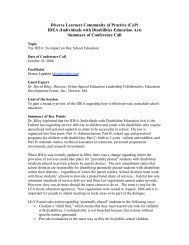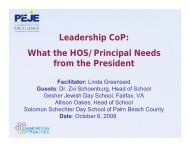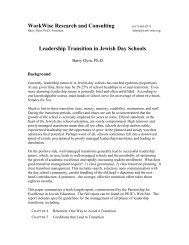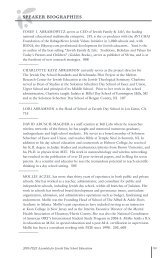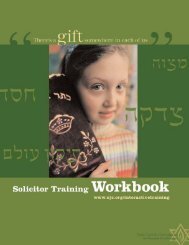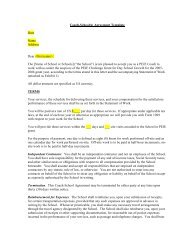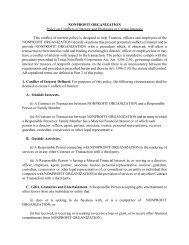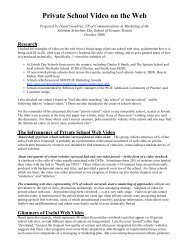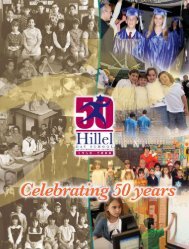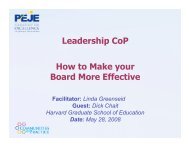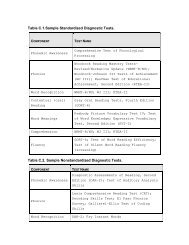âA Lifetim e of Learningâ - Partnership for Excellence in Jewish ...
âA Lifetim e of Learningâ - Partnership for Excellence in Jewish ...
âA Lifetim e of Learningâ - Partnership for Excellence in Jewish ...
You also want an ePaper? Increase the reach of your titles
YUMPU automatically turns print PDFs into web optimized ePapers that Google loves.
It is 2,500 years s<strong>in</strong>ce the first event and1,900 s<strong>in</strong>ce the second. So too, as long asJews live, we will remember Auschwitz andTrebl<strong>in</strong>ka, Bergen Belsen and Sobibor. Butthere is a <strong>Jewish</strong> way <strong>of</strong> remember<strong>in</strong>g. Forevery tragedy there is the promise <strong>of</strong> redemption.Every nightmare is succeeded byhope. We were never paralysed by our past,because we lived toward the future. That iswhy the <strong>Jewish</strong> response to catastrophewas to have children and build schools andcreate a <strong>Jewish</strong> future. The children <strong>of</strong> theyeshiva and Hasidic communities are theirHolocaust memorials, made not <strong>of</strong> stonebut <strong>of</strong> new life.These three moments are sem<strong>in</strong>al to an understand<strong>in</strong>g<strong>of</strong> <strong>Jewish</strong> history. At each <strong>of</strong>them, the <strong>Jewish</strong> people confronted its ownmortality. In none was the response thateventually proved successful by any meansthe obvious one. Who <strong>in</strong> his right m<strong>in</strong>dwould have suggested that the answer tothe Babylonian conquest, the might <strong>of</strong>Rome, or the Holocaust lay <strong>in</strong> schools,teachers, and houses <strong>of</strong> study? Yet Judaism’sgreat visionaries, the architects <strong>of</strong>its survival, said just that. Alternativeswere tried. They failed. The ten tribes <strong>of</strong>the Northern k<strong>in</strong>gdom disappeared. So didthe Sadducees and Essenes.In each case the survivors were ostensiblythe weakest group. The southern k<strong>in</strong>gdom<strong>of</strong> Judah was small <strong>in</strong> comparison to thek<strong>in</strong>gdom <strong>of</strong> the north. The Pharisees werepoorer and less powerful than the Sadducees.After the Shoah, the Hasidic andyeshiva communities were a fragment <strong>of</strong>their <strong>for</strong>mer glory. But <strong>in</strong> each caseZechariah’s prophetic maxim proved true.<strong>Jewish</strong> cont<strong>in</strong>uity happens “not by mightnor by power but by My spirit.”In our time, those diaspora communities that have failed to place <strong>Jewish</strong> education at the centre<strong>of</strong> their lives are disappear<strong>in</strong>g too.Recent Research F<strong>in</strong>d<strong>in</strong>gsThus far the test <strong>of</strong> history. What <strong>of</strong> currentresearch? Can we quantify the impact <strong>of</strong><strong>Jewish</strong> education on <strong>Jewish</strong> identity? Theanswer is that we can.The 1990 National <strong>Jewish</strong> Population Survey<strong>in</strong> the United States is the most comprehensivestudy <strong>of</strong> a diaspora communityundertaken <strong>in</strong> recent years. Its results arestill be<strong>in</strong>g analysed. But <strong>in</strong> March 1993 thefirst f<strong>in</strong>d<strong>in</strong>gs emerged <strong>of</strong> the effect <strong>of</strong> educationon <strong>Jewish</strong> commitment, us<strong>in</strong>g thesurvey data. The study, by Sylvia BarackFishman and Alice Goldste<strong>in</strong>, divided educationalexperience <strong>in</strong>to four categories: [1]no <strong>Jewish</strong> education, [2] m<strong>in</strong>imal education(less than three years <strong>of</strong> <strong>Jewish</strong> school orup to five <strong>of</strong> Sunday-only classes), [3] moderateeducation (three to five years <strong>of</strong> supplementaryor day school, or six years <strong>of</strong>Sunday-only classes) and [4] substantialeducation (six or more years <strong>of</strong> supplementaryor day school).Its f<strong>in</strong>d<strong>in</strong>gs were these. In the 25-44 yearoldage group, those who had substantial<strong>Jewish</strong> education were between six and tentimes more likely to observe <strong>Jewish</strong> ritualthan those whose <strong>Jewish</strong> education wasm<strong>in</strong>imal or non-existent. They were nearlythree times more likely to belong to a <strong>Jewish</strong>organization, three times more likely tobe members <strong>of</strong> a synagogue and twenty percent more likely to contribute to <strong>Jewish</strong>causes. They have more <strong>Jewish</strong> friends, aremore opposed to <strong>in</strong>termarriage and are significantlyless likely to marry out. Of thosewith no <strong>Jewish</strong> education, only three out <strong>of</strong>ten are <strong>in</strong>-married. Of those with substantial<strong>Jewish</strong> education, the figure is eight out<strong>of</strong> ten. The authors conclude:The 1990 NJPS data show us the strongcorrelation <strong>of</strong> <strong>Jewish</strong> education and enhanced<strong>Jewish</strong> identification. The mere fact<strong>of</strong> hav<strong>in</strong>g received some <strong>Jewish</strong> education<strong>in</strong> childhood has little impact on <strong>Jewish</strong> attitudesand behaviours dur<strong>in</strong>g the adultyears. However, extensive <strong>Jewish</strong> educationis def<strong>in</strong>itively associated with higher measures<strong>of</strong> adult <strong>Jewish</strong> identification. Its impactis demonstrated <strong>in</strong> almost every area<strong>of</strong> public and private life.Here then is further confirmation <strong>of</strong> thethesis that the fate <strong>of</strong> the Jews <strong>in</strong> the diasporawas, is, and predictably will be, determ<strong>in</strong>edby their approach to education. Thisproposition has been subjected to twotests, one <strong>in</strong>volv<strong>in</strong>g critical moments <strong>in</strong><strong>Jewish</strong> history, the other us<strong>in</strong>g the latestand best available research. Together theyshow that Jewry’s triumphs are triumphs<strong>of</strong> education. Our renewal depends oneducation. Our traditional strength, ourgreatest gift, our highest value is education.Pr<strong>of</strong>essor Daniel Elazar, <strong>in</strong> his encyclopaedicsurvey <strong>of</strong> world Jewry, People andPolity, draws the simple conclusion:The history <strong>of</strong> the Jews has been ahistory <strong>of</strong> communities built aroundschools. They are the key <strong>in</strong>stitutionsbecause they convey learn<strong>in</strong>g. Greekcivilization survived <strong>for</strong> five hundredyears after the Roman conquest <strong>of</strong> theGreek city-states, because the Greeks,like the Jews, had developed academiesand they could live around those academies.When the academies failed, Greekcivilization disappeared. The <strong>Jewish</strong>people has never allowed its academiesto fail. That is the secret <strong>of</strong> our collectiveimmortality.P A G E 16 • C O N T I N U I T Y M A G A Z I N E



